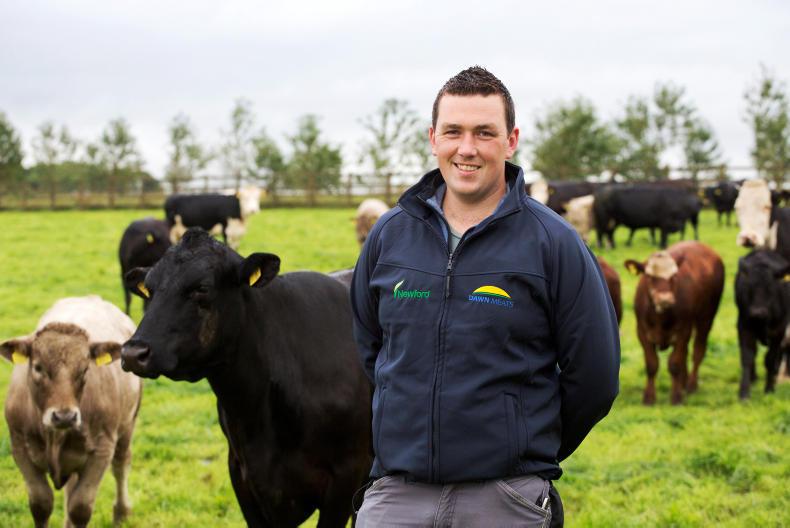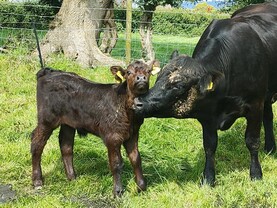A constant positive for the Newford herd in the last three years has been its breeding performance. Farm manager Matthew Murphy has brought the best out of the cows, with breeding performance among the top herds in the country.
Table 1 details the improvement in calving interval since the programme commenced. The strong performance has also allowed the farm to switch from a combination of AI and stock bulls to 100% AI for the 2019 breeding season.
The positive trend in recent years has been repeated in 2018, with 91 of the 100 cows put forward for breeding scanned in-calf. This is a similar performance to 2017, despite the difficult spring, the breeding season being a week shorter at 10 weeks and 100% AI being used.
Analysis of the scanning results shows 60 cows holding to first service, which represents a conception rate of over 60%, with 90% of the herd submitted for AI in the first three weeks of the breeding season. There were 20 cows which held to second service, while 11 cows held to third service. There were also four sets of twins identified.
Positive performance was also noted in the replacement heifers which are being contract-reared by Billy Gilmore, with 20 of the 25 heifers scanned in-calf after a seven-week breeding season. This, in turn, has set the farm up for another compact calving season, with over 80 cows due to calve in the first three to four weeks of calving in 2019.
Solid foundation
There are a number of factors contributing to the positive performance. Strong focus is placed on nutrition at key stages.
Preparation starts well in advance of calving, with cows penned on body condition score and fed accordingly. Cows in excessive condition are put on restricted intake in mid-gestation, while cows falling below a body condition score of 2.5-plus are supplemented, with 12 cows fed soya hulls at a rate of 1kg to 2kg last winter.
Cows were also prioritised in terms of management this spring, with turnout of yearling steers and heifers delayed to prioritise grass supplies for cows. Cows were grazed in 24-hour paddocks and only housed for a short duration, despite challenging ground conditions.
Body condition score is also currently under the spotlight, with Table 2 detailing a breakdown by parity of cow liveweight, body condition score and calf performance to weaning. Cow liveweight and condition is running behind the same period in 2017, with drought limiting performance.
First-calvers and thin cows have been segregated from the herd and are now receiving preferential treatment. The lift in grass growth and the fact that cows were housed on 1 September 2017 should hopefully allow them to make up any shortfall.
Calving difficulty has a direct correlation with breeding performance. There were 84 normal calvings in 2018, 12 with some assistance, nine with considerable difficulty and none requiring veterinary assistance, while there has only been one caesarean section from over 400 calvings.
The following criteria used for sire selection is viewed as delivering the optimum balance between calving ease and maximising the beef credentials of sires selected, while Table 3 details a breakdown of the sires selected.
Five stars on terminal index.Less than 7% calving difficulty for mature cows. Less than 6% calving difficulty for first- and second-calvers. Reliability of greater than 80% on calving difficulty.Greater than 30kg predicted carcase weight for mature cows, greater than 25kg for first and second calvers.Cost of less than €15 per straw. Breeding performance
Watch the interview with Matthew Murphy below.
A constant positive for the Newford herd in the last three years has been its breeding performance. Farm manager Matthew Murphy has brought the best out of the cows, with breeding performance among the top herds in the country.
Table 1 details the improvement in calving interval since the programme commenced. The strong performance has also allowed the farm to switch from a combination of AI and stock bulls to 100% AI for the 2019 breeding season.
The positive trend in recent years has been repeated in 2018, with 91 of the 100 cows put forward for breeding scanned in-calf. This is a similar performance to 2017, despite the difficult spring, the breeding season being a week shorter at 10 weeks and 100% AI being used.
Analysis of the scanning results shows 60 cows holding to first service, which represents a conception rate of over 60%, with 90% of the herd submitted for AI in the first three weeks of the breeding season. There were 20 cows which held to second service, while 11 cows held to third service. There were also four sets of twins identified.
Positive performance was also noted in the replacement heifers which are being contract-reared by Billy Gilmore, with 20 of the 25 heifers scanned in-calf after a seven-week breeding season. This, in turn, has set the farm up for another compact calving season, with over 80 cows due to calve in the first three to four weeks of calving in 2019.
Solid foundation
There are a number of factors contributing to the positive performance. Strong focus is placed on nutrition at key stages.
Preparation starts well in advance of calving, with cows penned on body condition score and fed accordingly. Cows in excessive condition are put on restricted intake in mid-gestation, while cows falling below a body condition score of 2.5-plus are supplemented, with 12 cows fed soya hulls at a rate of 1kg to 2kg last winter.
Cows were also prioritised in terms of management this spring, with turnout of yearling steers and heifers delayed to prioritise grass supplies for cows. Cows were grazed in 24-hour paddocks and only housed for a short duration, despite challenging ground conditions.
Body condition score is also currently under the spotlight, with Table 2 detailing a breakdown by parity of cow liveweight, body condition score and calf performance to weaning. Cow liveweight and condition is running behind the same period in 2017, with drought limiting performance.
First-calvers and thin cows have been segregated from the herd and are now receiving preferential treatment. The lift in grass growth and the fact that cows were housed on 1 September 2017 should hopefully allow them to make up any shortfall.
Calving difficulty has a direct correlation with breeding performance. There were 84 normal calvings in 2018, 12 with some assistance, nine with considerable difficulty and none requiring veterinary assistance, while there has only been one caesarean section from over 400 calvings.
The following criteria used for sire selection is viewed as delivering the optimum balance between calving ease and maximising the beef credentials of sires selected, while Table 3 details a breakdown of the sires selected.
Five stars on terminal index.Less than 7% calving difficulty for mature cows. Less than 6% calving difficulty for first- and second-calvers. Reliability of greater than 80% on calving difficulty.Greater than 30kg predicted carcase weight for mature cows, greater than 25kg for first and second calvers.Cost of less than €15 per straw. Breeding performance
Watch the interview with Matthew Murphy below.






 This is a subscriber-only article
This is a subscriber-only article










SHARING OPTIONS: